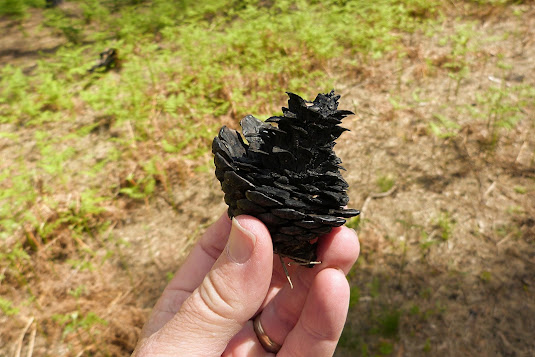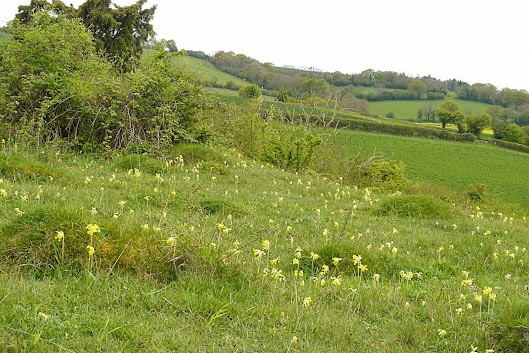Saturday 4th May 2024.
We took a drive north today, up to the superb area of Woolmer Pond and the Forest and Heath beyond, a place I always refer to as a mini New Forest. The weather was perfect with hardly any wind and bright sunshine brought out a good variety of birds, flowers and insects to entertain us three old Codgers! After Woolmer Pond, spurred on by some nice butterflies seen, I wanted to try my luck at nearby Noar Hill for the Duke of Burgundy butterflies, a site where they are famous for them and draws many admirers to this beautiful part of Hampshire. But first, there were two Moth Boxes to check both at my house and Andy’s house and I was in for a few new moths for the year too.
The Moth Boxes.
Kicking off the day at 4.45am (what on earth…….?), I got out of bed and eventually checked the moth box and the surrounding area. Two more ‘year-ticks’ were found that included a Yellow-barred Brindle perched on the outside kitchen wall and a Buff Ermine, which, unfortunately, I could not photograph as the moth dropped into my neighbours garden while I was trying to pot the damn thing! These moths like to ‘play dead’ when handled and so the moment was lost when I tried to get a photo of it. Other moths present included the following: 2 Double-striped Pugs and 6 Light Brown Apple Moths. After picking Geoff up and arriving at Andy’s house, I quickly got into his moth trap, but there were very few moths. Just two Brimstone Moths were present, which was really disappointing. Yes, it was clear overnight, but I did expect more to be here.
Woolmer Pond, nr Bordon:
After parking up in the small car park nearby, Geoff, Andy and myself made our way to the Pond where we listened out for any Spotted Flycatchers along the woodland footpath leading to the Pond. Sadly, none to be heard or seen, but Chiffchaffs, Blackcaps and Great Tits could be heard singing unseen within the woodland. On reaching the perimeter road, we walked anticlockwise first to view the southern end of the Pond and scrub. From here, we came across a gorgeous Garden Warbler singing and showing fairly well up in the trees opposite the Pond, the bird was seen later in the trees and bushes just south of the Pond. A second singing male was discovered close by the original bird.
A good scan over the Pond looking north, Geoff picked out a lone Sand Martin flying over, while on the Pond itself, up to two pairs of Little Grebes could be seen along with Mallard and Tufted Duck. Canada Geese were present, including a pair with two Goslings. A Red Kite drifted low overhead and all the plumage detail could be clearly seen in the bright sunshine. There was no sign of any Tree Pipit here on territory (a good spot here every year for this species), but I did find a male Stonechat nearby and several Linnets in the Gorse bushes. As we started making our way clockwise around the Pond, I found what I thought was a female Siskin feeding with Goldfinches high up in the trees, but on closer inspection, it was in fact a Lesser Redpoll! A Woodlark could be heard singing somewhere overhead and I soon picked out the bird distantly flying high near the woodland over on the east side of the Pond.
I was checking the plants as we walked on and there was literally a carpet of blue and purple with both Germander Speedwell and Storksbill all along the edge of the road. ‘Proper’ wild Bluebells were seen as well, which in turn attracted a lot of small Damselflies, notably the ‘Teneral’ type that were flitting along in their near see-through form. However, there seemed to be plenty of Large Red Damselflies on the wing and these were joined by good numbers of Four-spotted Chaser dragonflies that seemed to be everywhere. As it happens, this in turn was good news for the local Hobbies here of which we were lucky to see at least two birds this morning feeding over the large lake by Woolmer Forest.
As we made our way to the Cottage for a cup of coffee from our respective flasks, Geoff saw our first Cuckoo of the year flying west low over the scrub to the north. Our first of two ‘year-tick’ today and pleased with our first Cuckoo of the year, we made our way into the garden. From here, we watched a pair of Goldcrests having a bit of a tussle in a Conifer and a singing Chiffchaff high up in a dead tree. Andy found a female Blackcap up in one of the trees and another Woodlark was heard to sing somewhere north of where we sat by the old fallen tree. There was a lot of Bracken growing here in the garden and this attracted at least three Peacock butterflies and at least one Holly Blue butterfly.
As we neared the Forest, it didn't take long to find the Hobbies going about chasing dragonflies over the large pond area in front of Woolmer Forest, both taking advantage of the dead Conifers out on the heath. Though a little distant, the birds performed superbly and if you had a long lensed camera, I think you would of been in for a treat. A pair of Stonechats nearby were concerned by our presence as they were looking after two fledgeling youngsters close by and were also joined by a female Reed Bunting and two Chaffinches in the same small Silver Birch. A few Common Buzzards could be soaring in the distance as we made our way along the track and then up flew our second ‘year-tick’ of the day, a Tree Pipit. The bird sat on an exposed branch on one of the Conifers and allowed me a fairly close approach to take a few photos. A Redstart could be heard singing nearby, but we never got onto the bird. Yet, another Woodlark was heard singing and this time, I located the bird perched high on a conifer by the edge of the Forest singing its heart out.
As we walked through the Forest, we noticed that there must have been a Forest fire here because the base of all the trees were scorched and black. In fact, the fire must have gone into the heath beyond the Forest as most of the area was black and sporting grass and Bracken instead of Heather and Gorse. Who knows how much wildlife was lost here and I was not aware that there was a fire here recently and can only assume it happened earlier this year? On a positive side, I could see new plants growing in the Forest and I am sure it will rebuild itself over the coming months. On reaching the other side of the Forest, we took in the sheer beauty of the area and one can see why I call it the ‘mini New Forest’. The different shades of green in the distance is simply stunning in the sunshine and overhead, we admired a group of raptors soaring that included two Red Kites and three Common Buzzards circling amongst each other. Bliss. As we walked along the footpath here, our first Small Copper butterfly of the year was found nectaring on a small flower which Geoff quickly identified as Lousewort. This then gave me the idea of paying Noar Hill a visit for a species I have never seen before, the Duke of Burgundy of which the guys quickly agreed to. From our viewpoint overlooking the heath and woods in the distance, we could hear another Tree Pipit singing in the distance, which kind of rounded off our trip here and so we made our way slowly back to the car, enjoying good views of the Dragonflies and Damselflies and also the Hobbies on the way back. It's a stunning place that never disappoints and thankfully, very few ‘non-birders’ explore. We did come across a couple of birders who also enjoyed the Hobbies and told us that they had seen some Crossbills earlier.
Noar Hill, nr Selbourne:
Unfortunately, the clouds were closing in when we parked in the road near Noar Hill, though I was optimistic in seeing the ‘star’ butterfly of which we did. It was more luck than judgment as a young lady, who was also looking for butterflies with her son, spotted a Duke of Burgundy and quickly pointed it out to us as we were walking up the footpath on the Hill. Lucky for us, the butterfly landed and we were quickly onto the insect though it mostly had its wings closed. Never mind, even the underwing is stunning to look at as I grabbed a lot of photos of the said insect. Over the moon with the sighting, surely with all the Cowslips around, of which the whole area was carpeted in them (what a sight!), there surely must be more of these small butterflies around, but with it being overcast overhead, butterflies were very hard to come by. In fact, the only butterflies seen were a Holly Blue and a Peacock during the couple of hours we were there. So we decided to concentrate on the Orchids growing here of which Early Purple Orchids were also growing abundantly.
There was another unusual species here that I have never ever seen before; Fairy Shrimps. Earlier last month, both Matt and Emma Parkes paid a visit here and found where the Fairy Shrimps were and sent me photos of them. Geoff knew where to look for them and after finding a few large puddles caused by tractors most likely and now filled with rain water, we soon found these small creatures in good numbers in one of the larger puddles! Incredible looking things and apparently, Geoff was telling us that when the puddles dry out, the creatures buy themselves deep within the mud and come back out again when the rut fills with rain water again! Amazing stuff.
The bird life here was also not bad either with good numbers of singing Yellowhammers around and a supporting cast of singing Common Whitethroat, Blackcap and Chiffchaff as well as soaring Common Buzzards overhead. A Green Woodpecker was heard somewhere nearby and a Marsh Tit showed well for us and actually chased and nearly caught a Holly Blue butterfly. Geoff said that this site was also good in the Autumn for passing migrants. The viewpoints overlooking the countryside here were breathtaking and one could easily spend all day here. We are sure to come back soon here for more butterflies and plants as well as the birds in the near future.












































No comments:
Post a Comment